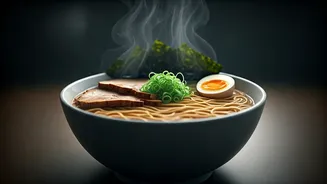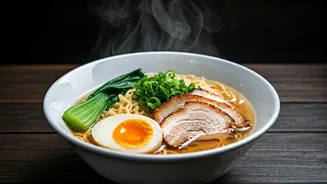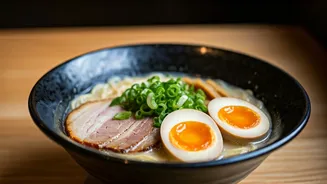Ramen's Fascinating History
Ramen, a dish that has captivated taste buds globally, traces its roots back to early 20th-century Japan. The story begins with Chinese immigrants who
introduced wheat noodles to Japan. Over time, Japanese chefs adapted these noodles, blending them with local ingredients and flavors, giving rise to the iconic ramen we know today. After World War II, ramen truly exploded in popularity as a cheap and readily available meal, fueling a ramen boom that continues to this day. The rapid proliferation of ramen shops signifies not only its deliciousness but also its ability to adapt and be personalized. Each region and even each restaurant adds its unique touches, making ramen a constantly evolving and exciting culinary adventure.
Key Ramen Ingredients
The soul of a perfect ramen bowl lies in its core ingredients: the broth, noodles, toppings, and the all-important tare. The broth can range from tonkotsu (pork bone) to shoyu (soy sauce-based), each offering a distinctive depth of flavor. Ramen noodles, typically made from wheat flour, water, salt, and kansui (an alkaline water giving them their signature texture and color), come in various thicknesses and shapes to best complement the broth. Toppings are a crucial part, with tender chashu pork, marinated soft-boiled eggs, nori seaweed, and fresh scallions often making appearances. Finally, the tare, a concentrated seasoning base consisting of salt, miso, or soy sauce, binds everything together, creating the final flavor profile that differentiates one ramen type from another.
Ramen: Regional Variations
Ramen is celebrated for its regional diversity. Each area of Japan has its unique take on this dish, reflecting local tastes and culinary traditions. For example, Hakata ramen, originating from Fukuoka, is known for its rich, creamy tonkotsu broth and thin, straight noodles. Sapporo ramen, on the other hand, is distinguished by its miso-based broth and the addition of corn and butter. Tokyo ramen, a classic style, features a shoyu-based broth with curly noodles and typically includes chashu pork and bamboo shoots. These regional differences highlight the versatility of ramen and demonstrate the chefs' creative approaches and influences from different culinary environments. Exploring these regional variations offers a fascinating taste of Japan’s varied flavors.
Perfecting Your Ramen
Creating the ultimate ramen experience involves several factors. First, consider the quality of the broth. It should be rich, flavorful, and carefully balanced. Next, pay close attention to the noodles. They should have a firm yet satisfying bite. Do not forget the toppings, which must be fresh, well-prepared, and chosen to complement the broth and noodles. When assembling your bowl, begin with the tare, add the broth, and arrange the noodles. Carefully placing the toppings will enhance the aesthetic appeal and flavor profile. Remember, a great ramen is a harmony of flavors and textures, with each element playing a crucial role. Savor each sip and enjoy the layers of taste in your meticulously crafted bowl.
Ramen Etiquette and Enjoyment
Enjoying ramen isn't just about the food; it's also about the experience and cultural traditions. Slurping the noodles is considered a compliment to the chef, as it enhances the flavor and cools the noodles, allowing you to enjoy them at the optimal temperature. It's perfectly acceptable to lift the bowl to your mouth to help you slurp and scoop up the broth. After finishing the noodles, you can drink the remaining broth directly from the bowl, absorbing the flavors. Remember to appreciate the craftsmanship and the effort that goes into each bowl. Respecting these traditions enhances your experience and connects you with the heart of Japanese cuisine. Enjoy the flavors and experience a true culinary delight.














